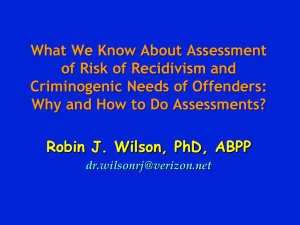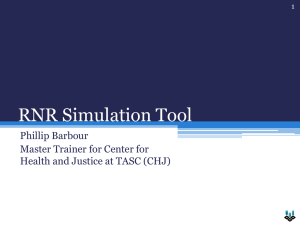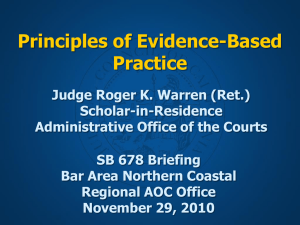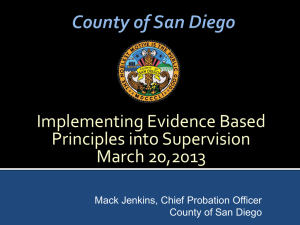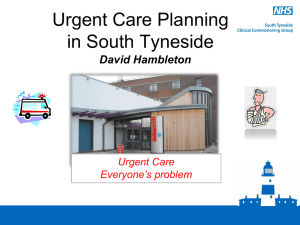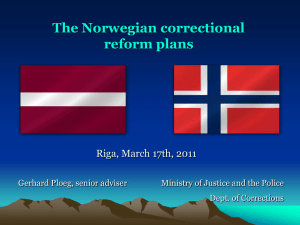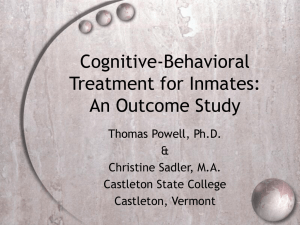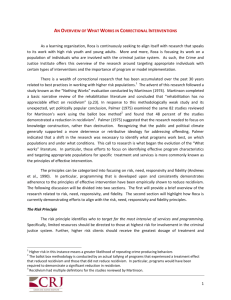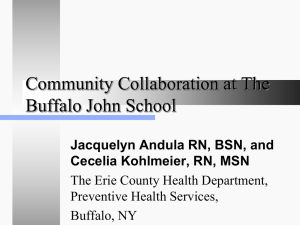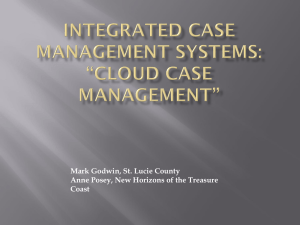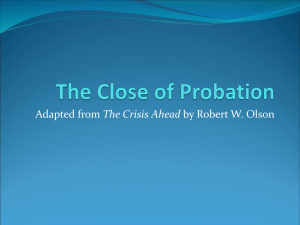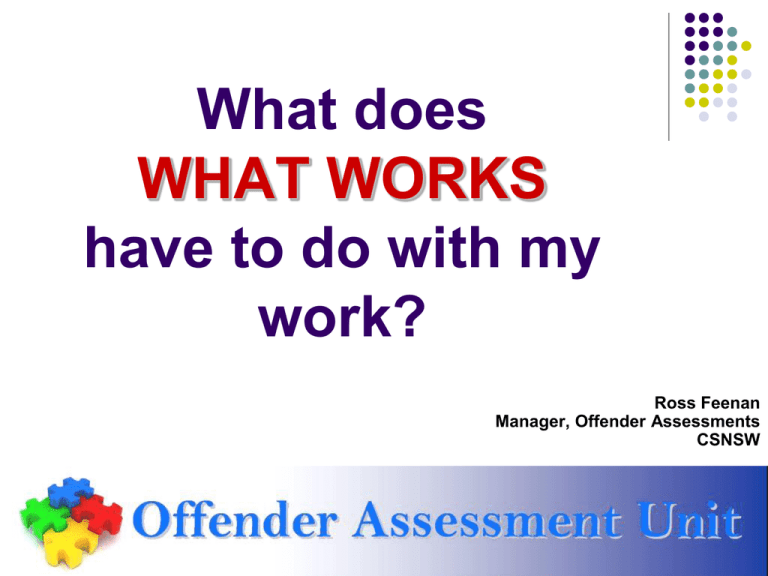
What does
WHAT WORKS
have to do with my
work?
Ross Feenan
Manager, Offender Assessments
CSNSW
What Works
– now moving in 2 separate ways
What Works
For Who & When
RNR plus
Good Lives Model
Desistance model
Maximising
effect sizes
Changing Organisational
Systems and Individual
work
RISK
WHO
TO TREAT
(and how much)
NEED
WHAT
TO TREAT
RESPONSIVITY
HOW
TO TREAT
Adherence to RNR Principles = Recidivism
0.7
Effect Size (r)
0.6
0.5
0.4
0.3
0.2
0.1
0
-0.1
General
None
Violent
One
Females
Two
Young Offenders
Three
Sex Offenders
R-N-R Principles
Have changed our organisations since 2001
ASSESSMENTS
– VISAT, ROR, ORNI-R, LSI-R, LS-CMI, LS-RNR,
YLSI, CVTRQ
PROGRAMS
– Groupwork, evidence based, accredited and
focused on “needs”
CASE MANAGEMENT AND INDIVIDUAL WORK?
Snapshot of
what Probation
Officers Do
Behind Closed
Doors
The Manitoba
“Black Box” Study
Bonta et. al. 2008
Manitoba
Black Box Study
(Bonta et al., 2004, 2008)
211 audiotapes of client interviews
a) Do offenders’ plans contain criminogenic needs?
b) Does supervision target identified criminogenic needs?
c) Are probation officers using the techniques associated with
reduced recidivism (i.e., cognitive-behavioural strategies,
problem-solving)?
d) Any differences?
The “Big Four”
Risk Factors
The “Central Eight” Risk Factors
The “Big Four” & “Central Eight”
Criminogenic Needs
History of antisocial behaviour
Antisocial personality pattern
Antisocial cognition
Antisocial associates
Family and/or marital
School and/or work
Leisure and/or recreation
Substance abuse
Assessment → Plans
Only 39% of identified needs (using the PRA) had a
matching intervention strategy
Need
Assessed In Plan
Substance Abuse
37%
79%
Emotional
23%
71%
Employment
41%
10%
Peer Problems
48%
Attitude
56%
Not
recorded Too few
Adherence to the Need Principle?
Need Area
% Discussed
When Need Present
Family/Marital
90
Substance Abuse
78
Employment/Academic
57
Peer Problems
21
Attitudes
9
Probation Conditions & Recidivism
Compliance with the probation conditions is
a fact of community supervision
Time
Recidivism
10 minutes
18.9%
15 minutes or more
42.3%
Rates adjusted for risk level
But too much emphasis can backfire
Targeting Criminogenic Needs:
Effecting Recidivism
Discussing criminogenic needs were
related to reduced recidivism
More focus on criminogenic needs, lower
the recidivism
Length of Discussion
Recidivism (n)
Low (0-15 minutes)
59.8% (49)
Medium (20-30 minutes)
47.6% (26)
High (40+ minutes)
33.3% (3)
2009 NSW Replication Study
Joanne Kennedy replicated Black Box study
in 2009
Total sample – 1,666
Looked at the relationship between
Assessment (LSI-R), case plan factors, case
plan strategies and discussion case notes
Similar patterns were found
Assessment → Plan (NSW)
“CONSIDERABLE NEED FOR
IMPROVEMENT” – LSI-R
Education/Employment
Finances
Family/Marital
Accommodation
Leisure/Recreation
Companions/Associates
Alcohol/drug problems
Emotional/personal
Attitude/orientation
Factor
Strategy
84%
31%
68%
70%
23%
21%
94%
82%
34%
54%
13%
56%
34%
22%
32%
93%
81%
17%
Discussion of Needs (NSW)
Number of
interviews where
Factor was relevant
Number of interviews
where factor was
discussed
Education/Employment
Finances
Family/Marital
69%
32%
66%
48%
22%
48%
Accommodation
Leisure/Recreation
Companions/Associates
45%
21%
21%
40%
11%
20%
Alcohol/drug problems
Emotional/personal
Attitude/orientation
83%
62%
30%
69%
54%
17%
Criminogenic Needs (LSI-R)
STICS:
(Strategic Training Initiative
in Community Supervision)
Training in the RNR model of
Community Supervision
Bonta, Bourgon, Rugge, Scott, Yessine, Gutierrez & Li (Nov 2011)
STICS format
3 Day Training
Teach skills to facilitate change in RNR framework
Teach the “how to” with clients
Provide structure
On-Going Clinical Support
Monthly STICS Meetings
Refresher Course
Feedback on audiotapes
Effects on Probation Officers
STICS Officers
v
Untrained “Control” Officers
Relevant & Irrelevant Discussions?
Is time spent on…
Criminogenic needs
Focus on procriminal attitudes
Or…
Non-criminogenic needs
Probation conditions
Percent
Addressing what matters most…
Overall Officer Interview Skills
STICS
mean z score
Control
Structuring
Relationship
Behavioural
Techniques
Cognitive Techniques Effective Correctional
Skills
So Evidence says…
STICS changes PO behaviour
Enhances the officers’ RNR practices
More focus on criminogenic needs, especially
antisocial attitudes
Less spent on non-criminogenic needs & the
conditions of probation
Better relationship, structuring & cognitivebehavioural skills for interpersonal influence
Effects on Clients
Did STICS reduce recidivism?
Are client outcomes different?
“Personal” caseload recidivism rates at
1 & 2 Years
PO Effectiveness?
Before vs. After STICS
Recidivism before STICS
Note: No Differences: STICS PO higher
recidivism prior to training
Recidivism after STICS
Note: 13% Difference
Even greater reductions in recidivism was achieved for those who continued with
the monthly meetings, feedback and refresher courses (15% )
1 Year Recidivism Differences
Group
Pre
Post
Change
Control
34%
33%
↓ 1%
STICS
33%
24%
↓ 9%
41%
15%
↓ 26%
with some clinical support
STICS
with high clinical Support
Intensive Training and Support
in What Works Works!
Intensive RNR training improves PO skills &
Interventions
Intensive RNR training reduces reoffending
On-going clinical support very important
Cognitive Behavioural skills hardest to learn
Requires time & clinical support
SO HOW DO WE GET HOLD OF IT?
Or do we attempt it ourselves??
Is it worth it?
YES
It works. Working with
clients this way reduces
recidivism.
Adhering to RNR
principles has to be
organisational,
functional, be
supported in policy and
in practice.
NO
Costly to put all staff
through thorough
training and have
ongoing STICS type
support
Only one study so far
Some staff are already
over “What Works”
STICS Report
More information on STICS:
www.publicsafety.gc.ca
Or contact
ross.feenan@dcs.nsw.gov.au
Manager, Offender Assessments
Corrective Services NSW

